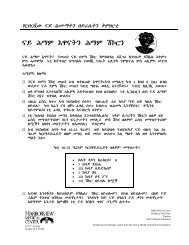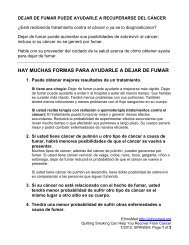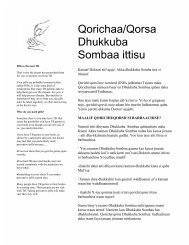Somali Knowledge Attitude Practices Study (KAPS) - EthnoMed
Somali Knowledge Attitude Practices Study (KAPS) - EthnoMed
Somali Knowledge Attitude Practices Study (KAPS) - EthnoMed
You also want an ePaper? Increase the reach of your titles
YUMPU automatically turns print PDFs into web optimized ePapers that Google loves.
The gum of Hildid tree is mixed with water and given to the child three times a day, about 30-60<br />
minutes before meals for three months. The Hildid gum is believed to have a bad odour which<br />
makes the worms faint or die before coming out. The herbal mixture is given before meals to find<br />
the worms hungry and waiting with their mouths open to drink.<br />
Sheep oil (one teaspoon per day for seven days) or wool is also commonly used in the traditional<br />
treatment of intestinal worms. It is believed that the fat or wool from sheep is poisonous to the<br />
parasites and facilitates their expulsion from the stomach; hence all worms are believed to get out<br />
of the stomach by the 7 th day of treatment.<br />
In urban areas, the following additional methods are also used in treating worms:<br />
1) Use of pumpkin seeds as de-wormers: The pumpkin seeds are ground and cooked with<br />
maize and small amount of sesame oil. Once the child has eaten this mixture, the worms<br />
just roll out.<br />
2) De-worming with cooked green maize and hildid : The green maize is cooked in a<br />
small amount of sesame oil and hildid. As the maize is chewed by the child, its smell<br />
makes the worms come up the oesophagus to the mouth. The worms then faint and die.<br />
If the caregiver notices that the above methods have failed in treating the intestinal worms and the<br />
child is badly dehydrated it is taken to the hospital/ health facility.<br />
Measles:<br />
The study found that most people in almost all livelihood zones, including those in the urban<br />
areas, believe that there is no modern treatment for measles. Measles is therefore managed with:<br />
1) Smearing the blood from liver on the child’s body. The child is then washed in goat soup<br />
and put in a cool place. The child may be covered with a goat’s skin to keep warm.<br />
Because of the skin rash that accompanies the measles, children are instructed to avoid<br />
rubbing the eyes lest they become blind. For younger children and those who cannot<br />
control rubbing their eyes, the hands are tied to prevent them from rubbing the eyes. The<br />
goat milk is given to the child to drink four times a day to keep the throat agape.<br />
1) Giving the sick child meat and soup of did-dik (sagaroo) animal<br />
2) In parts of Lower Juba children with measles are fed on faecal matter of the dik-dik<br />
(sagaroo) mixed with water until the child recovers. There are usually no side effects<br />
experienced with this method of treating measles.<br />
3) Feeding the child on honey, sagaroo meat and soup. The sagaroos are often bought from<br />
the hunters. The honey is given one teaspoon per day.<br />
4) Bathing the child in goat-milk every morning for three days.<br />
Acute Malnutrition (nafaqodaro)<br />
Acute malnutrition, locally known as nafaqodoro, is associated with poor food and sanitation.<br />
The two combine to cause malnutrition and treatment involves giving the child more food. No<br />
food is withheld during treatment of malnutrition. Medicine is used to treat accompanying<br />
diseases. In case of kwashiorkor, the swollen limbs, stomach and face are burnt to remove the<br />
fluid.<br />
Polio: Treatment of polio involves reading the Koran as a first step, followed massaging a small<br />
amount of sesame oil and water on the scalp, after which some ground leaves are boiled and<br />
placed on the head and washed off after about 1.5 hours. This practice is done once a day for at<br />
least three days. A piece of needle and copper wire together with a piece of hildid are then placed<br />
together in a small pocket and hang round the child’s neck. Malmal with a little hildid mixed with<br />
33






